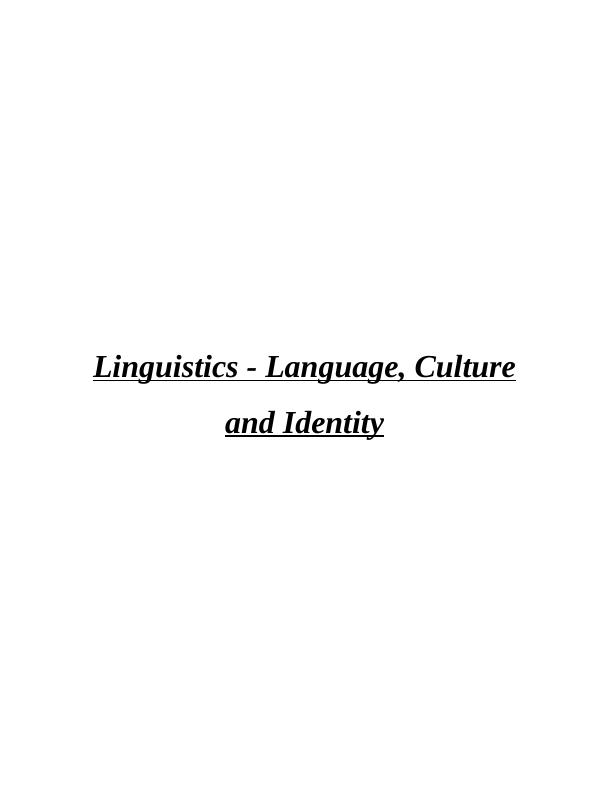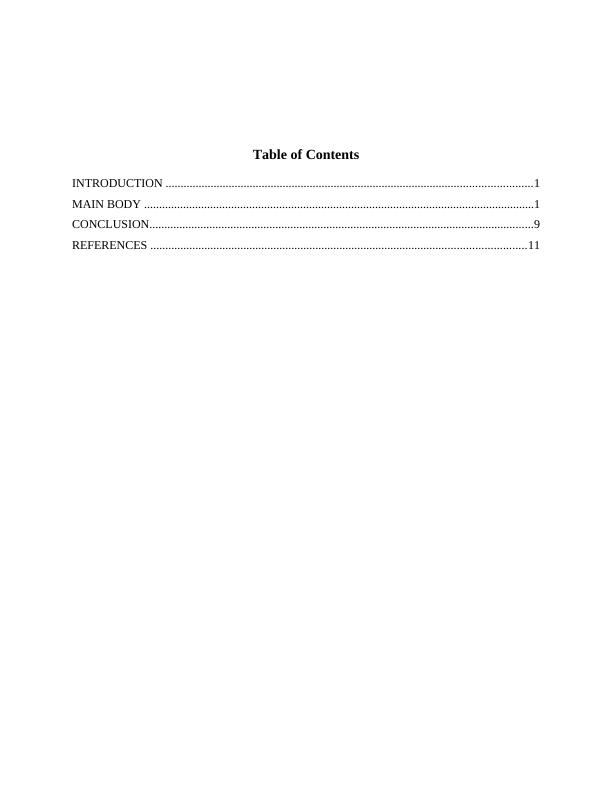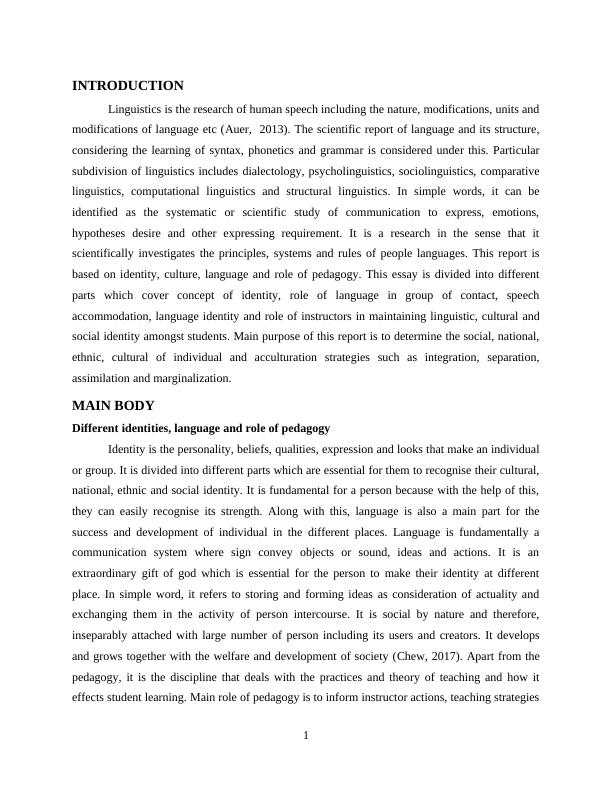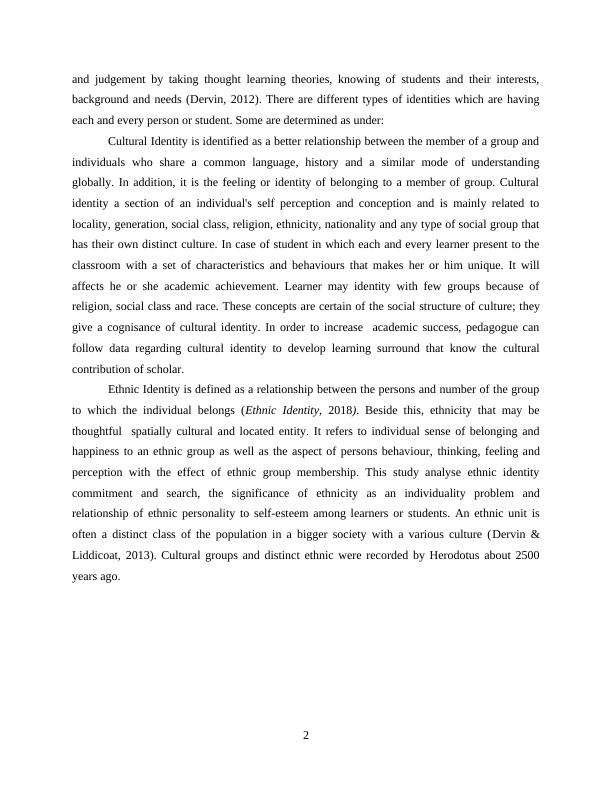Ask a question from expert
Linguistics - Language, Culture and Identity
13 Pages3948 Words152 Views
Added on 2020-10-04
Linguistics - Language, Culture and Identity
Added on 2020-10-04
BookmarkShareRelated Documents
Linguistics - Language, Cultureand Identity

Table of ContentsINTRODUCTION ..........................................................................................................................1MAIN BODY ..................................................................................................................................1CONCLUSION................................................................................................................................9REFERENCES .............................................................................................................................11

INTRODUCTION Linguistics is the research of human speech including the nature, modifications, units andmodifications of language etc (Auer, 2013). The scientific report of language and its structure,considering the learning of syntax, phonetics and grammar is considered under this. Particularsubdivision of linguistics includes dialectology, psycholinguistics, sociolinguistics, comparativelinguistics, computational linguistics and structural linguistics. In simple words, it can beidentified as the systematic or scientific study of communication to express, emotions,hypotheses desire and other expressing requirement. It is a research in the sense that itscientifically investigates the principles, systems and rules of people languages. This report isbased on identity, culture, language and role of pedagogy. This essay is divided into differentparts which cover concept of identity, role of language in group of contact, speechaccommodation, language identity and role of instructors in maintaining linguistic, cultural andsocial identity amongst students. Main purpose of this report is to determine the social, national,ethnic, cultural of individual and acculturation strategies such as integration, separation,assimilation and marginalization. MAIN BODY Different identities, language and role of pedagogyIdentity is the personality, beliefs, qualities, expression and looks that make an individualor group. It is divided into different parts which are essential for them to recognise their cultural,national, ethnic and social identity. It is fundamental for a person because with the help of this,they can easily recognise its strength. Along with this, language is also a main part for thesuccess and development of individual in the different places. Language is fundamentally acommunication system where sign convey objects or sound, ideas and actions. It is anextraordinary gift of god which is essential for the person to make their identity at differentplace. In simple word, it refers to storing and forming ideas as consideration of actuality andexchanging them in the activity of person intercourse. It is social by nature and therefore,inseparably attached with large number of person including its users and creators. It developsand grows together with the welfare and development of society (Chew, 2017). Apart from thepedagogy, it is the discipline that deals with the practices and theory of teaching and how iteffects student learning. Main role of pedagogy is to inform instructor actions, teaching strategies1

and judgement by taking thought learning theories, knowing of students and their interests,background and needs (Dervin, 2012). There are different types of identities which are havingeach and every person or student. Some are determined as under: Cultural Identity is identified as a better relationship between the member of a group andindividuals who share a common language, history and a similar mode of understandingglobally. In addition, it is the feeling or identity of belonging to a member of group. Culturalidentity a section of an individual's self perception and conception and is mainly related tolocality, generation, social class, religion, ethnicity, nationality and any type of social group thathas their own distinct culture. In case of student in which each and every learner present to theclassroom with a set of characteristics and behaviours that makes her or him unique. It willaffects he or she academic achievement. Learner may identity with few groups because ofreligion, social class and race. These concepts are certain of the social structure of culture; theygive a cognisance of cultural identity. In order to increase academic success, pedagogue canfollow data regarding cultural identity to develop learning surround that know the culturalcontribution of scholar. Ethnic Identity is defined as a relationship between the persons and number of the groupto which the individual belongs (Ethnic Identity, 2018). Beside this, ethnicity that may bethoughtful spatially cultural and located entity. It refers to individual sense of belonging andhappiness to an ethnic group as well as the aspect of persons behaviour, thinking, feeling andperception with the effect of ethnic group membership. This study analyse ethnic identitycommitment and search, the significance of ethnicity as an individuality problem andrelationship of ethnic personality to self-esteem among learners or students. An ethnic unit isoften a distinct class of the population in a bigger society with a various culture (Dervin &Liddicoat, 2013). Cultural groups and distinct ethnic were recorded by Herodotus about 2500years ago.2

End of preview
Want to access all the pages? Upload your documents or become a member.
Related Documents
Pedagogy for EAL Classrooms: Understanding Language Learning Journey of Diverse Learnerslg...
|13
|3182
|328
Language Policy and Planning - Australialg...
|16
|4256
|401
Language and its community functionslg...
|9
|2656
|478
Howard Gardner's Theory of Multiple Intelligences and Teaching Methodslg...
|8
|2727
|331
Interrelation Between the Language and the Communitylg...
|12
|3216
|36
Race and Ethnicitylg...
|13
|3193
|75